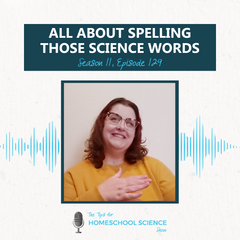FREE Shipping on all our products! (Please Note: Orders may experience a delay of a week or more in shipping due to the high volume of orders at this time of year.)
FREE Shipping on all our products! (Please Note: Orders may experience a delay of a week or more in shipping due to the high volume of orders at this time of year.)
What it looks like to use living books for science (Elementary Years) - Living Books Session, part 2 {Episode 39}
February 19, 2018 2 min read
What it looks like to use living books for science (Elementary Years) - Inspiring your students to love science through living books, Part 2 {Episode 39}
Now that we understand what living books are and how to choose one to use for science, it's time to look at how to use living books to teach science. In the second part of the "Inspiring your students to love science through living books" session, we are going to chat about what it looks like to use living books for science during the elementary years.
Hi, I’m Paige Hudson and you are listening to the Tips for Homeschool Science Show where we are breaking down the lofty concepts of science into building blocks you can use in your homeschool!
Listen to this episode
Share the Tips
If you found these homeschool science tips to be helpful, would you please take a moment to rate it on iTunes or Stitcher? This would help me tremendously in getting the word out so that more earbuds are filled with science-teaching encouragement.
Highlights

Basically, when you use living books for science with elementary students, you will:
- Read and enjoy
- Do oral and written narrations
- Complete hands-on projects
Goals for elementary science education are relatively simple.
- First, you want to create an interest in the student for learning science.
- Second, you want to fill the student’s mind with fascinating, but basic scientific information.
When you are teaching science to elementary students, you want to include the following:
- Scientific demonstrations – Demonstrations are more teacher-led scientific tests.
- Science-oriented Books – Living books with a science bent definitely fit the bill here!
- Notebooking – Basically you want a way to record what the students are learning.
- You can also add multi-week projects and memory work to round things out if you desire.
A Sample Week for Elementary Students
- Day 1 - Living Books and Notebooking
- Day 2 - Living Books and Notebooking
- Day 3 - Scientific Demonstration and Notebooking
- Day 4 and 5 - Add in some Optional Extras
Takeaway Tidbits
Elementary students are like an empty bucket begging to be filled. (Pin this Tidbit)
When you read living books with the elementary crowd your main focus is to introduce them to the material in an interesting way. (Pin this Tidbit)
Additional Resources
See the full conference session - Inspiring your students to love science through living books.
Check out the following articles for more tips on living books and elementary students:
Also in {Podcast} The Tips for Homeschool Science Show
All About Spelling Those Science Words {Season 11, Episode 129}
March 25, 2024 7 min read

In this episode, we'll be interviewing Robin Williams from All About Spelling. Click "Read More" to listen is as we discuss tips and tricks for spelling all those science words!
How should you handle notebooking through the different ages? {Season 11, Episode 128}
March 18, 2024 3 min read

Writing in Science with a Well-Trained Mind (Interview) {Season 11, Episode 127}
March 11, 2024 16 min read

Click "Read More" to listen in as Susan Wise Bauer and Susanna Jarret join Paige to share tips and tools about the third key to teaching science!
Subscribe
Sign up to get the latest on sales, new releases and more …


